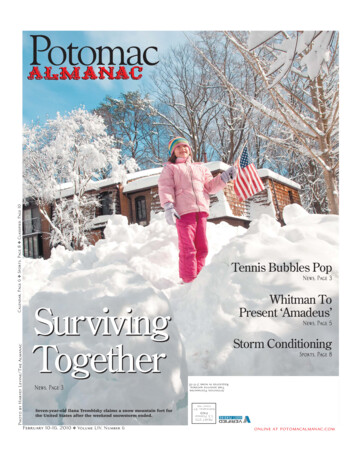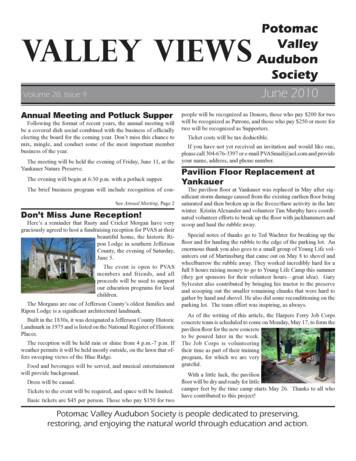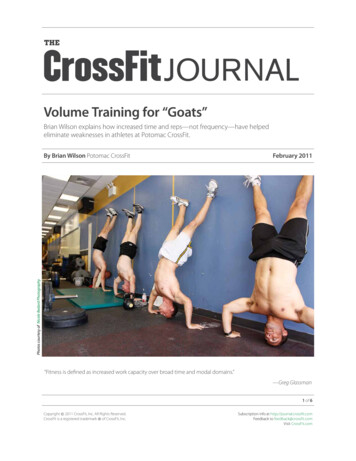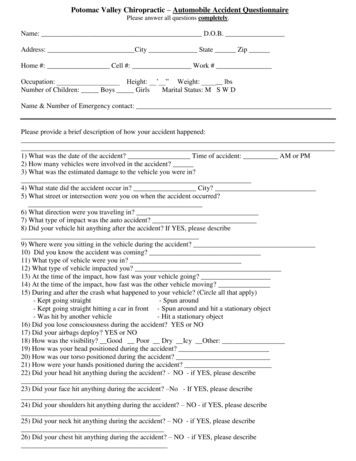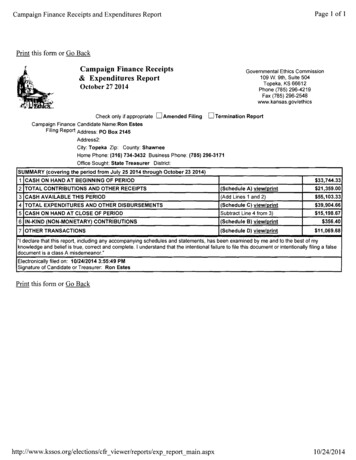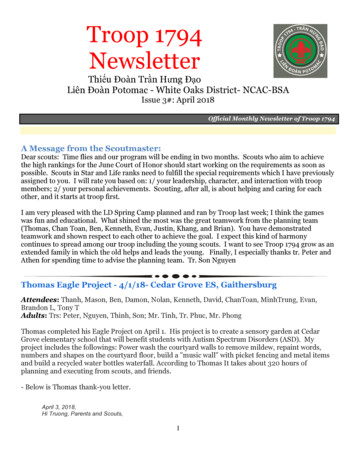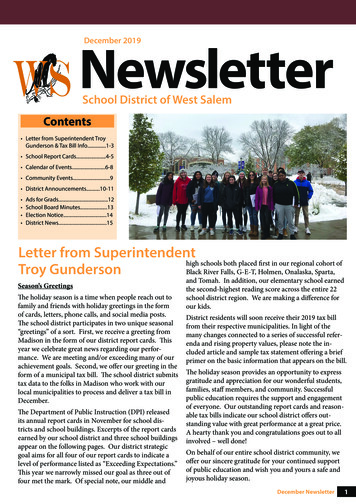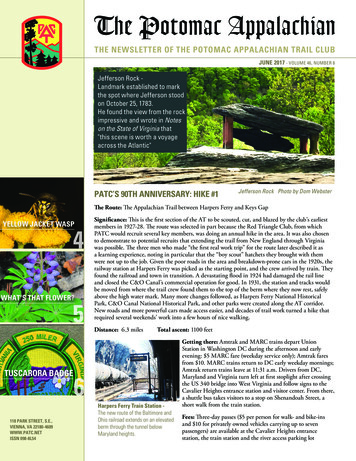
Transcription
THE NEWSLETTER OF THE POTOMAC APPALACHIAN TRAIL CLUBJUNE 2017 ‑ VOLUME 46, NUMBER 6Jefferson Rock Landmark established to markthe spot where Jefferson stoodon October 25, 1783.He found the view from the rockimpressive and wrote in Noteson the State of Virginia that"this scene is worth a voyageacross the Atlantic"PATC’S 90TH ANNIVERSARY: HIKE #1Jefferson Rock Photo by Dom WebsterThe Route: The Appalachian Trail between Harpers Ferry and Keys GapYELLOW JACKET WASP4WHAT'S THAT FLOWER?5TUSCARORA BADGE118 PARK STREET, S.E.,VIENNA, VA 22180‑4609WWW.PATC.NETISSN 098‑8L54Significance: This is the first section of the AT to be scouted, cut, and blazed by the club’s earliestmembers in 1927-28. The route was selected in part because the Red Triangle Club, from whichPATC would recruit several key members, was doing an annual hike in the area. It was also chosento demonstrate to potential recruits that extending the trail from New England through Virginiawas possible. The three men who made “the first real work trip” for the route later described it asa learning experience, noting in particular that the “boy scout” hatchets they brought with themwere not up to the job. Given the poor roads in the area and breakdown-prone cars in the 1920s, therailway station at Harpers Ferry was picked as the starting point, and the crew arrived by train. Theyfound the railroad and town in transition. A devastating flood in 1924 had damaged the rail lineand closed the C&O Canal’s commercial operation for good. In 1931, the station and tracks wouldbe moved from where the trail crew found them to the top of the berm where they now rest, safelyabove the high water mark. Many more changes followed, as Harpers Ferry National HistoricalPark, C&O Canal National Historical Park, and other parks were created along the AT corridor.New roads and more powerful cars made access easier, and decades of trail work turned a hike thatrequired several weekends’ work into a few hours of nice walking.Distance: 6.3 milesTotal ascent: 1100 feet6Harpers Ferry Train Station The new route of the Baltimore andOhio railroad extends on an elevatedberm through the tunnel belowMaryland heights.Getting there: Amtrak and MARC trains depart UnionStation in Washington DC during the afternoon and earlyevening: 5 MARC fare (weekday service only); Amtrak faresfrom 10. MARC trains return to DC early weekday mornings;Amtrak return trains leave at 11:31 a.m. Drivers from DC,Maryland and Virginia turn left at first stoplight after crossingthe US 340 bridge into West Virginia and follow signs to theCavalier Heights entrance station and visitor center. From there,a shuttle bus takes visitors to a stop on Shenandoah Street, ashort walk from the train station.Fees: Three-day passes ( 5 per person for walk- and bike-insand 10 for privately owned vehicles carrying up to sevenpassengers) are available at the Cavalier Heights entrancestation, the train station and the river access parking lot
near the intersection of US 340 andShenandoah Street. Credit cards areaccepted only at Cavalier Heights.References: PATC’s Appalachian TrailGuide to Maryland and NorthernVirginia (2015 edition), pages 112133; PATC Map #7 (Harpers Ferry toSnickers Gap); USGS Quad: HarpersFerry and Charlestown; National ParkService trail maps at nps.gov/hafe/planyourvisit.The TrailMiles0.0 The train station sits on a bermraised over the foundations of the arsenalraided by John Brown in 1859. Fromthe station, cross the parking lot andPotomac Street, then pass through acourtyard parallel to Shenandoah Street,which is about a half block to the left.At the next street, High Street, crossand go up the stone stairway, followingAT signs and white rectangular blazespast Jefferson Rock and views overVirginius Island (a center of industrialactivity before the Civil War) and theShenandoah River. (The white blazes thatnow mark the full length of the AT werenot used by the initial crew. They hadsome copper tags and wooden slats tomark turns and landmarks. They wieldedquickly dulling axes to clear a path.)1.0 Descend to Shenandoah Street andto this point has changed considerablyfrom the initial layout. The U.S. 340bridge replaced the one most likelyused by the founders. Before a flooddestroyed it in the mid-1930s, the oldbridge crossed the Shenandoah from apoint near the train station.)1.7 Cross WV 32 (Chestnut HillRoad) and turn east to follow an old,gullied roadbed. (The old road was builtby charcoal makers to supply the forgesat Harpers Ferry. As the forest grewback after the Civil War, wildfires wereamong the challenges faced by earlyand later volunteers in this area. Withalmost all the land in private ownership,passage had to be negotiated withowners, and few public resources wereavailable to fight fires. PATC respondedby funding the acquisition of someparcels, encouraging donation of others,and advocating the creation of parks.)1.9 Cross the charcoal road andclimb, steeply at times, with occasionalswitchbacks. (As noted by FrankSchairer, who was to become PATC’sfirst trail supervisor, another painfullesson was about the need for canteens.Finding no potable water on thedifficult climb, he noted, “we were alldying of thirst when we got to the top.”Within a year or so, this section mightbe relocated to ease the grade and helpcontrol erosion. When that happens,the route will be somewhat longer than6.3 miles.)2.1 Turn west to follow white blazesat the junction with a yellow-blazedtrail. Ahead, follow the old roadwaywest. (Wherever possible, the AT scoutsfollowed roads built by those cuttingtimber and making charcoal in earliertimes.)View from the AT as it passes under thecurrent route 340 bridge and crosses theShenandoah River.follow the U.S. 340 bridge to the southbank of the Shenandoah River.1.3 Turn left (east) at the end of thebridge and follow the AT under thebridge. On the west side, turn up theriverbank and begin the longest climbof the route – the ascent to LoudounHeights. (The route from the beginning2Sign at the inter section of AT and LoudounTrail - At the end of a long climb up from theriver, a sign marks the intersection with theAT and the Loudoun Heights Trail.2.4 At the crest of Loudoun Heights,turn right (west) once again to followthe AT at a junction with blue-blazedLoudoun Heights Trail. (Up to thispoint, the route is within Harpers FerryNational Historical Park, which wascreated during World War II. Shortlyafter leaving the park, the AT passesCivil War redoubts that were builtand then abandoned by Federal forces;Confederates under Gen. Thomas“Stonewall” Jackson occupied the areain 1862, helping to trap and capturesome 11,000 Union soldiers in the townbelow.)4.7 Pass the primitive but well-used"Four Mile Campsite" (used by manynorthbound hikers who want to passthrough Harpers Ferry early the nextmorning, because there is no legalcamping within Harpers Ferry HistoricalNational Park).4.8 Cross a powerline clearing. (Thepath that descends the clearing to theleft connects to trails in the Blue RidgeCenter for Environmental Stewardship.)6.0 Continue straight as another oldroad intersects from the west. (It tookseveral trips to reach this point. As FrankSchairer reported, “It took us all day toget from south of Chimney Rock to apoint about a half mile beyond” on thefirst day.)6.3 Reach WV 9 at Keys Gap. (Theparking lot and bulletin board with ATinformation just north of WV 9 areamong the many improvements that havemade the trail more accessible since 1927.A chronicler of early efforts to build thetrail noted that there were few decentroads on the east side of the ridge, andthe approach to Keys Gap from the westhad to deal with mud, rock, and deepruts. Before they could cut trail aroundthe gap, volunteers had to push their carup to the crest.)Further weekend work pushed thetrail down to Bluemont. When onlytwo volunteers were available for oneof the last trips, they visited a cabinnear Keys Gap to seek help. From theirown pockets, the PATC pair paid two“mountain boys” 50 cents apiece to workwith them for a day on a 2-mile stretch.These were the first recorded paid workerson PATC’s segment of the AT, andJune 2017 POTOMAC APPALACHIAN
among the last. Shortly after the routewas done, members of two ancestralhiking organizations, the Red TriangleClub and the Wildflower PreservationSociety, enjoyed a walk on it with some ofthe builders. The vision of a through trailalong the spine of the Blue Ridge tookroot, and more recruits stepped up for thenext stages of work.CAMPERS HAD FUNDESPITE HEAVY RAINAbout this series.Between 1927 and today, PATC’sfounders and their successors built a 240mile section of the Appalachian Trail,created the Tuscarora Trail, made dozensof cabins and shelters available to hikers,and took on maintenance responsibilityfor over 1,000 miles of paths in the club’s4-state service area. The hikes describedin this series pass landmarks in PATC’shistory and celebrate nine decades ofremarkable evolution in our nationaltrail network.Larry Broadwell and William Needhamco-write the series, and Brian Goudreauprovides the maps. John Hedrick andChris Brunton contributed to this firstentry.PATC History Map- A map of the current AT andthe original route Photo by WM NeedhamPATC Cadillac Crew leader KirstenElowsky provided adult support to the Redpatrol; Vigorous Hike Leader and Wolf TrapOverseer Mike Moran explained invasivespecies to the campers and supervised thecampers as they removed them from aroundthe Ranger building. Wolf Trap DistrictManager Alan Day led the campers ona hike on the Wolf Trap trail, built andmaintained by PATC.Youth leader from BSA Troop 55demonstrates how to pitch a tent to theFirst Time campers. Photo by Alan DayThe Wolf Trap First Time camper traditionof camping in the rain was continued duringthe 2017 event April 22-23. Twenty-nineFairfax County fifth and sixth graders,including 18 Title I kids, participated.Campers learned how to put up their tentsand cooked/cleaned up after their meals.The campers participated in archery, flycasting, bird watching, pollinator study, aFilene Center backstage tour, a short hikeand invasive plant removal. The heavy rainon Saturday did not seem to dampen theirenthusiasm. Fortunately, the rain movedout on Sunday for the hiking, backstagetour, invasive plant removal and animalantics activities.Super Activities were presented by Archeryfor Scouts, Orvis Tysons, Audubon Societyof Northern Virginia, Green Spring MasterOrvis Tysons fly fishing instructor RyanMcCarron helps First Time camper with flycasting. Photo by Alan DayPATC has supported these camp-outs byproviding volunteers, donating campingequipment (tents, sleeping bags, stoves,packs) and donating money to subsidizeneedy campers.These camp-outs touch on the objectivesof partnerships and youth outreach inthe PATC Strategic Plan adopted by themembership in 2015.Volunteer Fairfax has selected the First TimeCampers Program as the Volunteer Programfor 2017. Congressman Gerry Connolly(D-11th District) had the VolunteerFairfax recipients acknowledged in theCongressional Record. http://fowt.info/ .The fall camp-out will be held ColumbusDay weekend, Oct. 8 and 9.- Alan DayYouth leader from BSA Troop 55demonstrates three pot cleaning method tothe First Time campers. Photo by Alan DayGardeners, Meadowlark Botanical Gardensand Friends of Wolf TrapThis was the sixth camp-out sponsored byWolf Trap National Park for the PerformingArts. The trips are held in the spring andfall outside the performance season. GreatFalls-based Boy Scout Troop 55 and VentureCrew 364 youth leaders ran the camp-out,supported by adult leaders.June 2017 POTOMAC APPALACHIAN3
YELLOW JACKET WASPLittle hornetPart 1A yellow jacket is a type of wasp, thecollective name given to any member ofthe Order Hymenoptera (insects withmembranous wings) that is not an ant, a beeor a sawfly. The common name describes thepredominant yellow bands on the dorsal sideof the thorax, metaphorically a yellow jacket.They are simply called “wasps” in every otherEnglish-speaking country. Globally, thereare about 15,000 species of wasps, of which4,000 are indigenous to North America.Most wasp species use the sting as a meansof paralyzing their mostly arthropod prey toimmobilize them in order to lay eggs so thatthe hatchling larvae will be nourished. Thesewasps are called parasitoid, an intermediateterm between a parasite, which does not killits host, and a predator which kills multiplespecies; they are generally innocuous tohumans and are even considered benigndue to their control of insect pests. Waspsare noted for the very narrow appendagebetween the thorax and the abdomen.Ants have a similar “wasp waist” since theyevolved from wasps.Yellow jackets are in the Hymenopteransuborder Aculeata, which is derived fromthe Latin aculeus meaning sting, theirmost notable trait. The suborder is definedaccording to the evolutionary mutation oftheir egg-laying ovipositor organ into anefficient venom delivery device. The aculeatewasps that live in colony groupings aretaxonomically assigned to the sub-familyVespinae and may be called either yellowjacket (genus Vespula) if they have thecharacteristic black and yellow markings,or hornet (genus Vespa), their larger, darkercousins - mostly black with some yellowishmarkings on the head and thorax.The Latin word for wasp is vespa; the yellowjacket is then the “little wasp.” Aculeateyellow jacket wasps are also divided intotwo groups: The benign V. rufa live insmall colonies and use the sting only as an4offensive weapon to paralyze prey; and thepestiferous V. vulgaris live in large coloniesand use the sting as a means of colonydefense. The colony arrangement is knownas eusocial, a relatively modern biologicalterm that refers to arthropods (bees, ants,termites and some yellow jacket wasps) thatlive in large, complex societies in whicha division of labor prevails according todifferences in size, sex and sometimes shape.According to the noted Harvard biologistEdward Wilson in “The Social Conquest ofEarth,” eusocial insects evolved because oftheir nest building behaviors; the traditionalalternative view is that the division of laborarose independently and the nest becamea necessary adjunct for colony growth andmaintenance. In either case, the palladiumof the nest is the essence of the colony. Asa result, the nest is defended with faroucheferocity whenever a threat is perceived;yellow jackets emerge en masse to strike atany unwary interloper, hikers included, withmultiple defensive stings.The queen is the cynosure of Hymenopteransociety; there is no king. Eusocial societiesare structurally matriarchal; the onlyfunction of the male is to provide someDNA diversity to promote evolutionaryadaptability. The survival of the yellowjacket species depends on the success of thequeen in finding a safe haven to survive thewinter months and equally on her ability tostart a colony with vernal warming.The queen’s Herculean labors begin with theconstruction of a below ground or hypogealnest (epigeal in some species) made fromplant fibers that are assiduously removedfrom decayed wood and assembled intoabout thirty cells for egg deposition; a paperlike shroud made from masticated celluloseprovides a protective covering. The vespinelarvae that emerge from each egg must eachbe fed for several weeks until they pupate tometamorphose into adult female workers.The queen is the sole provider and protectorof the colony for the first and most criticalmonth of its existence; she must competewith myriad other arthropods for flowernectar to nourish her larval offspring andcatch and malaxate insect prey to providethe proteins needed for growth.The unrelenting duties of larval care persistuntil midsummer, when the emergentfemale workers take over the mundanechores of the nest and relieve the queen tofocus on her primary oviposition purpose. Aperiod of Malthusian growth ensues as theworkers build more cells for more workers inthe expanding, multi-layered vespine nest.Ultimately, between 500 and 4,000 femaleworkers will have constructed between2,500 and 10,000 cells, the differencesin size and population a matter of theserendipitous choice of a good location withadequate food resources.As summer wanes to the senescence ofautumn, cells are constructed for thegrowth of new queens and a small numberof necessary (but sufficient) males; thenext generation queens and their attendantmales depart the nest haven with theYellow Jacket- The common name yellowjacket for the "little hornet" wasp describesthe predominant yellow bands on the dorsalside of the thoraxPhoto by Wm Needhamsingle-mindedness of procreation for speciespropagation. The males almost immediatelydie as the mission of consummation iscompleted by the lucky few; the new,fertilized queens carry their future offspringto carry the cycle of life through winter tothe following spring. The female workersand the original queen are left behind tosuccumb to their inexorable fate of colonycollapse, the nest an empty paper shelltestimonial to their passage.There are two species of yellow jacket thatwarrant special consideration: the southernyellow jacket (V. squamosa) indigenousto southeastern North America, and theEuropean yellow jacket (V. germanica)indigenous to Eurasia but globally invasiveand notably aggressive. Both species areconsidered significant pests, particularlyin warmer climates where their nests canbecome perennial rather than dying out atthe annual onset winter and can thereforeexpand annually to gargantuan size andpopulation.According to the USDA Handbook“Yellow Jackets of North America,” a nestof southern yellow jackets was found inFlorida with 14 comb levels and 120,130June 2017 POTOMAC APPALACHIAN
cells (presumably enumerated by meticulouscount); however the record goes to a nestof invasive European yellow jackets foundin New Zealand that was 15 feet tall,had about 180 combs with an estimatedpopulation in the tens of thousands. Thelarger nests become unkempt with carcassesof dead prey and dead workers accumulatingat the margins; southern yellow jackets evenallow cockroaches to roam their nests asscavengers in one of the more interestingexamples of mutualism.Part two will discuss some of the sociologicalissues associated with yellow jackets inthe next issue of the PA; it is appropriatelysubtitled “hiking dystopia.”and a huge inflorescence, up to 18 inches.It is also called Garden Lupine becausethe large inflorescence makes it a gardenfavorite. In the east it only grows naturallyin the northern states and Canada.In our area we have only one Lupine—Sundial Lupine (L. perennis—perennial).Its leaves have 7-11 leaflets. The flowers arebluish-purple or occasionally white. Theones I have seen have a relatively fat keel,light blue with darker blue veins and apurple banner, and no wing petals showing.It blooms from April to June. I have seen iton Reddish Knob and on the bank acrossfrom where we park for a hike in RunklesGap in the Massanutten.- Wm NeedhamWHAT’S THAT FLOWER:PEA FAMILY SPRINGFLOWERSI can tell a Lupine (genus Lupinus fromthe Latin for “wolf” because it was thoughtto destroy the soil) by its leaves. They aretypical of the pea family, divided with entireleaflets, but they are palmate -- arranged likeyour hand, the leaflets all branching froma single point. The leaflets are longer thanwide and form a fan or circle around thecenter. The flowers grow on a spike at thetop of the plant. Each flower has the typicalpea family shape: two petals at the bottomjoined to form a keel, an upright bannerpetal at the top and two almost unnoticeablewing petals.Lupine- Lupine leaflets branch from a singlepointThe western states have many Lupinespecies. There are fifty in Oregon, forexample. East of the Mississippi we haveonly two. Bigleaf Lupine (L. polyphyllus—many leaves or leaflets) has 12 to18 leafletsJune 2017 POTOMAC APPALACHIANGoat’s Rue- Goat’s Rue flowers have awhite to light yellow banner forming abackground to the bright pink keelGoat’s Rue (Tephrosia virginiana) flowersare spectacular. The banner of the one-halfto three-quarter-inch flower is white to lightyellow, forming a background to the brightpink keel. One or more flowers appearamong the leaves at the end of branches.The leaves are pinnate (resembling afeather with leaflets on opposite sides of anelongated axis with many leaflets. The stemsand leaves are covered with hairs, the sourceof the genus name, which means hoary orash-color in Greek.All parts of this plant are toxic to people andlivestock, hence Goat’s Rue. Look for it inJune in dry, acidic places like the sandstonebased trails of the Massanutten andGreat North Mountain and ShenandoahNational Park. “Finding Wildflowers inthe Washington-Baltimore Area” by CristolFleming, Marion Blois Lobstein and BarbaraTufty says it grows on the bare rocks of BearIsland on the Maryland side of Great Fallsand on the rocky bluffs below Great FallsTavern.Wild peas (Lathyrus—Greek name for“pea”) and vetches (Vicia—the Latin namefor the plant) are herbaceous (non-woody),trailing or climbing vines, notable for tendrilsat the end of branches. Vicia stems arecylindrical. Lathyrus stems are winged orangled/four-sided. The leaves of both generaare pinnate.Common Vetch (Vicia sativa—sown) isthe earliest to bloom, starting in Marchand continuing into June. The pink/purpleflowers are up to an inch long and growsingly or in pairs in leaf axils. They arealmost stemless. It is not native and canbe an agricultural pest. I have seen it onWildcat Mountain near Warrenton, at theFront Royal 4-H Center, and in my yard.“Finding Wildflowers in the WashingtonBaltimore Area” says it grows in the openfields of Piscataway Park across the Potomacfrom Mount Vernon and Calvert Cliffs StatePark.Wood Vetch- Wood Vetch racemes have7-20 pale lavender to white, loosely attachedflowersPhotos by Richard StrombergHairy Vetch (Vicia villosa—long-hairy)blooms from May to September. As thename implies, it is covered with one to twomillimeter hairs. The racemes can have upto 40 violet and white flowers, all on oneside of the stem. It is not native and can bean agricultural pest. I have seen it on theAT north of Elk Wallow in ShenandoahNational Park.Wood Vetch (Vicia caroliniana—ofCarolina) is common along woodland trails.It blooms from April to June. It is native.The racemes have 7-20 pale lavender to whiteflowers attached loosely, not one sided.The large (one-inch) flowers of Perennial Pea(Lathyrus Latifolius—broad leaved) makeit a common garden plant. It looks like thesweet-smelling garden plant, Sweet Pea (L.odoratus), which is an annual. PerrenialPea, as the name implies, is a perennialplant and is also used in gardens, but it does5
not have an odor. The flowers are pink/purple (occasionally white). The stems aredistinctly winged. A pair of long, veinyleaflets grow at the end of the stem with abranching tendril beyond. It is not nativebut has escaped from gardens. I have seen iton North Fork Mountain in West Virginiaand on the AT near Chimney Rocks inPennsylvania.Veiny Pea (Lathyrus venosus—veiny) hasa square stem so you can feel the corners.The 8-14 leaflets are wider than the otherspecies discussed this month, and they areveiny underneath, giving the species itsname. Five to 20 flowers dangle from theflower stem. They are purple and can be aninch long. It blooms from May to July. Itis native. I have seen it on the Snead Farmloop in Shenandoah National Park, on theMassanutten Trail near Woodstock Tower,and near the Pawpaw Tunnel. “FindingWildflowers in the Washington-BaltimoreArea” mentions the open bedrock terrace inGreat Falls Park, Virginia.- Richard StrombergCOUNCIL MEETINGSUMMARYincreased cabin rental rates to Septemberfailed. The majority believed that therewas time to explain the increase tothe membership before the currentimplementation date of July 1.--A motion for the club to appoint arepresentative on the board of the GreatEastern Trail Association passed.--An updated agreement with theShenandoah Mountain Rescue Group wasapproved.--It was decided not to have a “gala”fundraising event this summer.--A motion to change the nature and venueof the annual membership meeting waswithdrawn to be resubmitted with moredetails about alternatives.After the meeting adjourned, there was aninformal discussion of the important issue ofthe recruitment and supervision of the paidstaff. This discussion was not part of theformal meeting and no actions or decisionswere taken.TUSCARORA BADGEApril 11, 2017This is a summary of the PATC councilmeeting held on April 11. For more details,consult the minutes and attachments on thePATC website.The meeting started with reports fromofficers and committee chairs. The staffdirector announced that the club hasthree paid positions open—new cabincoordinator, finance coordinator, andaccounting assistant. The positions werebeing advertised. Other reports:--The club will be taking on trailmaintenance on Monocacy trails inMaryland.--New members meetings will resume onthe first Wednesday of every month.--Larry Broadwell will produce a series ofarticles on hikes that honor the club’s 90thanniversary.--A new book on walks in Green andMadison Counties will be published soon.--The club commented on the MountainValley and Atlantic Coast pipeline projects.The council acted on several motions:--A motion to delay the implementation of6The Potomac Appalachian Trail Club, incooperation with REI, is offering a freepatch and rockers to recognize successfulhikes of the rugged Tuscarora Trail.The patch and rockers are available to boththru hikers and section hikers. Here's howyou can earn the patches:Thru Hikers: Hikers who complete a thruhike of the Tuscarora Trail will receive a freeTuscarora Trail patch and five patch rockers;four rockers for each state through whichthe trail passes and one that identifies thehiker as a "250 Miler".Section Hikers: Section hikers earn theTuscarora Trail patch and the applicablestate rocker upon completing the trail inany of four states. A section hiker can earnall the state rockers in any order, and uponfinishing the entire trail the hiker is eligibleto receive the "250 Miler" rocker.The process to receive the patch and rockersis simple: Describe in an e-mail the itineraryfollowed to complete the thru hike orspecific state and send it tottpatches@patc.net.Please include a mailing address.- John HedrickLOOKING FOR MATERIALSFOR NEW MEMBERMEETINGSSupervisor of Membership SteveMcLaughlin will be re-institutingmonthly New Members Meetings on thefirst Wednesday of every month. Themeetings will begin in May in the largeconference room on the first floor at PATCHeadquarters. Wednesday evenings werechosen because the cabin and sales desksare staffed with volunteers on Wednesdaynights.Steve is developing material for inclusion inthe New Member Meeting and expects tohave about a 30-minute orientation sessionfollowed by a Q&A session. If you haveany suggestions for Steve to include in hisorientation session, please contact him atMembershipSup@patc.net. Steve hopes todevelop a standard powerpoint presentationthat could be used by local chapters andspecial interest sections, as well things likethe Combined Federal Campaign or otherpublic presentations.NEW RATESThe PATC will raise the rental rates for itscabins effective July 1. Occupancy on orafter that date will be at the new rates. Therate increase was approved by the council inDecember 2016.Cabin rental rates have not been increasedfor six years. In 2011, the rate for each cabinwas raised by 5. In 2008, there was asimilar 5 increase. These modest increaseshelp meet the higher costs that the clubfaces.Cabin income is the primary financialsupport for important club work like trailmaintenance, shelter upkeep, conservationand advocacy. Increased generalmaintenance costs as well as extraordinaryJune 2017 POTOMAC APPALACHIAN
June 2017 POTOMAC ertLittle CoveGypsy SpringJohn's RestVirginiaPennsylvaniaGlass VirginiaVirginiaCliff's HouseWest Va.VirginiaBlackburn Tr. Ctr.HorwitzVirginiaArgow CabinHighacreSNPGWNFSugar KnobSNPRock SpringSNPRange ViewMarylandOlive ageJones MountainSNPPennsylvaniaDoyles RiverSNPPennsylvaniaMarylandCatoctin Hollow LodgeDawsonVirginiaCorbinMarylandBears Den CottagePennsylvaniaWHERELOCATEDBear SpringAnna rimitiveCABINTYPE228488841010481271288614PATCMAP# MILESFROM 365565910571150120PATC MEMBER ONLY CABINSF109105-62-31011411--105-685-62-3None1 mile3.2 miles0.8 mile0.8 mile0.2 mileNone40 feet3.8 miles0.8 mile0.2 mile0.4 mile0.2 mile1.4 miles0.7 miles0.3 mile0.4 mile1 mileCABINS AVAILABLE TO THE PUBLICMAXIMUMCAPACITY0.2 mile1 mileN/A0.2 mile0.1 mile0.1 mileN/A60 feet5.9 milesN/A0.7 mile0.3 mileN/A1.5 milesN/A300 feet0.8 mile0.3 mileDISTANCETO THE 72-3G--11101029110091726510685115105110None0.1 mile0.3 mileNoneNoneNoneNoneNoneNone0.4 mileNoneN/A2.9 miles4 miles2.9 milesN/A30 feet1.2 milesN/AN/AN/AN/A*There is a 6 per night charge for each person over 15 people for the use of Blackburn Trail sYesYesPETSALLOWED 110.00 80.00 50.00 135.00 110.00 155.00 90.00 100.00 175.00 50.00 90.00 140.00 * 55.00 35.00 45.00 45.00 45.00 35.00 50.00 45.00 35.00 50.00 45.00 35.00 45.00 140.00 75.00 50.00 50.00PER NIGHT RATETHU/FRI/SAT 70.00 50.00 35.00 80.00 70.00 90.00 50.00 60.00 90.00 35.00 50.00 80.00 * 40.00 25.00 30.00 30.00 30.00 25.00 35.00 30.00 25.00 35.00 30.00 25.00 30.00 80.00 50.00 35.00 35.00PER NIGHT RAT
Ferry and Charlestown; National Park Service trail maps at nps.gov/hafe/ planyourvisit. The Trail Miles 0.0 The train station sits on a berm raised over the foundations of the arsenal raided by John Brown in 1859. From the station, cross the parking lot and Potomac Street, then pass through a
